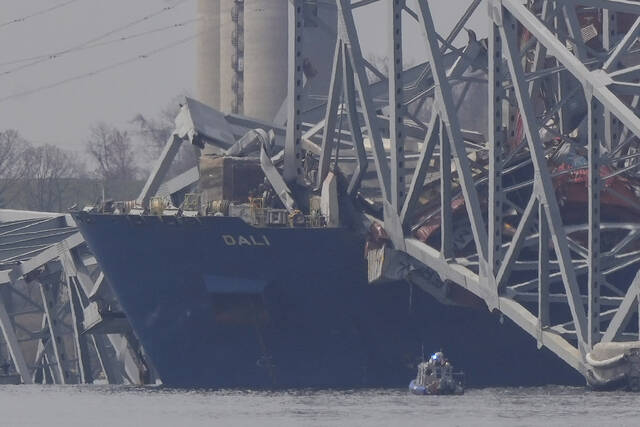Editorial: The lessons of Pittsburgh, Philadelphia and Baltimore bridges
Baltimore’s Francis Scott Key Bridge is a twisted mass of metal in the Patapsco River today after a cargo vessel plowed into a support column. Video shows the incident in the dark hours of Tuesday morning like a slow motion scene in a disaster movie as the structure fell down like a broken toy.
It felt unreal. We know it isn’t. We’ve been here before.
It was the third bridge to fall in just over two years. It started with the Fern Hollow Bridge in Pittsburgh, which dropped early morning commuters into a ravine in January 2022. In June 2023, a gas tanker truck rolled over under a span of Interstate 95 in Philadelphia. The heat melted steel, and the bridge collapsed before firefighters could arrive.
There have been others, like the Sanibel Causeway in Florida, partially collapsed by Hurricane Ian in 2022, but it was repaired in less than a month. Less than two weeks after the Philadelphia overpass fell, a railroad bridge over the Yellowstone River in Montana toppled, derailing a train carrying hot asphalt. But these incidents — important to their areas as they were — were not major failures in major cities.
Pittsburgh, Philadelphia and Baltimore are points of a triangle that represent hubs of commerce and large populations. The lines between those points are important avenues for national transportation.
That all three experienced similar calamities in such short order is troubling. It isn’t the conspiracy theory kind of conjecture that almost immediately mushroomed on social media. That’s almost expected at this point.
It’s that these incidents point to the critical importance of our infrastructure, transportation and interconnected economy.
The rapid responses to both Pittsburgh and Philadelphia showed what can be accomplished in an emergency — when a disaster is triaged and the priority must be recovery as quickly and completely as possible. The importance of the Baltimore port to shipping promises fast action, too.
But just like an emergency room is no replacement for good preventive medicine, our infrastructure cannot be measured in our response to a bridge collapse — or two or three.
The federal Infrastructure Investment and Jobs Act of 2021 put $1.2 trillion into the nation’s critical structures and systems. That is the framework of the investment. Government at every level must do its part to fill out the rest.
Asked about the Baltimore collapse, Allegheny County Public Works Director Stephen Shanley said a similar incident in Pittsburgh would be “extremely unlikely” because of the size of the cargo ship involved versus the kind of barges that have periodically struck piers of the area’s many bridges.
The investigation of the Fern Hollow Bridge collapse shows that the real fear isn’t a boat the size of a floating city careening unstopped into a support. The downfall is the day-to-day work of maintenance, inspection and repair which is too easy to delay or neglect entirely.
Two years removed from the collapse, with that ringing indictment from the National Transportation Safety Board fresh in mind, the awareness is real.
But how long before it is easy to push something off for a few months or a few years? That idea might feel unreal, but we know it isn’t. We’ve been here before.
Remove the ads from your TribLIVE reading experience but still support the journalists who create the content with TribLIVE Ad-Free.

